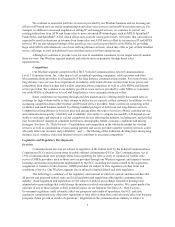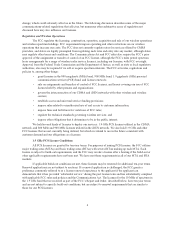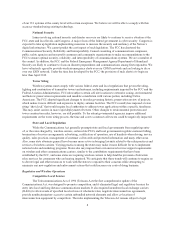Sprint - Nextel 2008 Annual Report Download - page 17
Download and view the complete annual report
Please find page 17 of the 2008 Sprint - Nextel annual report below. You can navigate through the pages in the report by either clicking on the pages listed below, or by using the keyword search tool below to find specific information within the annual report.Mergers or other business combinations involving our competitors and new entrants, including new
wholesale relationships, beginning to offer wireless services may also continue to increase competition. These
wireless operators may be able to offer subscribers network features or products and services not offered by us,
coverage in areas not served by either of our wireless networks or pricing plans that are lower than those offered
by us, all of which would negatively affect our average revenue per subscriber, subscriber churn, ability to attract
new subscribers, and operating costs. For example, AT&T, Verizon and T-Mobile now offer competitive
wireless services packaged with local and long distance voice and high-speed Internet services, and flat rate
voice and data plans. Our prepaid services compete with several regional carriers, including Metro PCS and Leap
Wireless, which offer competitively-priced prepaid calling plans that include unlimited local calling. In addition,
we may lose subscribers of our higher priced plans to our prepaid offerings.
One of the primary differentiating features of our iDEN network is the two-way walkie-talkie service.
Several wireless equipment vendors, including Motorola, which supplies equipment for our Nextel-branded
service, have begun to offer wireless equipment that is capable of providing walkie-talkie services that are
designed to compete with our walkie-talkie services. Several of our competitors have introduced devices that are
capable of providing walkie-talkie services. If these competitors’ services are perceived to be or become
comparable, or if any services introduced in the future are comparable to our Nextel-branded walkie-talkie
services, a key competitive advantage of our Nextel service would be reduced, which in turn could adversely
affect our business.
Failure to improve wireless subscriber service and failure to continue to enhance the quality and features of
our wireless networks and meet capacity requirements of our subscriber base could impair our financial
performance and adversely affect our results of operations.
Although we must continually make investments and incur costs in order to improve our wireless
subscriber service and remain competitive, due to, among other things, the current economic conditions, we are
carefully targeting how and where we spend our capital on network and service enhancements. Over the past few
years, we worked to enhance the quality of our wireless networks and related services by:
‰maintaining and expanding the capacity and coverage of our networks;
‰securing sufficient transmitter and receiver sites and obtaining zoning and construction approvals or
permits at appropriate locations;
‰obtaining adequate quantities of system infrastructure equipment and devices, and related
accessories to meet subscriber demand; and
‰obtaining additional spectrum in some or all of our markets, if and when necessary.
Our current budget and focus on careful spending will require us to make decisions on the necessity and
timing of certain network enhancements. We may not continue to update our network at the same rate as in
previous years. If our competitors spend on their network and service enhancements while we are curtailing our
nonessential spending, their networks could perform at levels superior to ours, which could negatively affect our
ability to attract new subscribers or retain existing subscribers.
Any network and service enhancements we decide to make may not occur as scheduled or at the cost
that we have estimated. Delays or failure to add network capacity, failure to maintain roaming agreements or
increased costs of adding capacity could limit our ability to satisfy our wireless subscribers, resulting in
decreased revenues. Even if we continuously upgrade our wireless networks, there can be no assurance that
existing subscribers will not prefer features of our competitors and switch wireless providers.
Current economic conditions, our recent financial performance and our debt ratings could negatively impact
our access to the capital markets resulting in less growth than planned or failure to satisfy financial covenants
under our existing debt agreements.
Although we do not believe we will require additional capital to make the capital and operating
expenditures necessary to implement our business plans or to satisfy our debt service requirements for the next
few years, we may need to incur additional debt in the future for a variety of reasons, including future
15
























